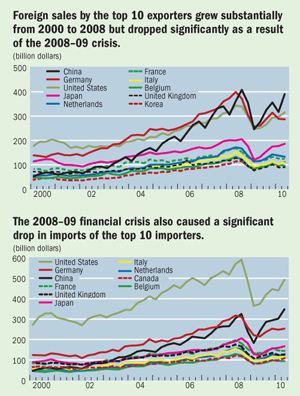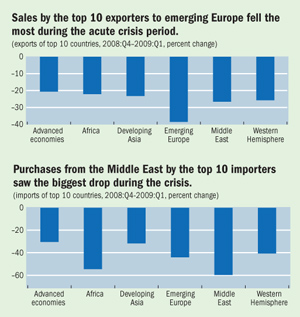Trade Impact
Finance & Development, December 2010, Vol. 47, No. 4
The Great Recession seriously disrupted international trade, but some were hit harder than others

WORLD exports grew substantially from 2000 to 2008, particularly among the world’s top three exporters—China, Germany, and the United States. In China, for example, exports grew by nearly 700 percent during the period, paralleling the rapid growth of its economy. This growth came to a halt as a result of the 2008–09 financial crisis. Between October 2008 and March 2009, foreign sales by the top 10 exporters—which account for about 50 percent of world exports—dropped by 34 percent. But since then exports have rebounded rapidly. By the second quarter of 2010, the top 10 exporters had recovered 55 percent of their decline during the crisis.
The growth in world imports that preceded the Great Recession was equally impressive. During 2000–08, the top 10 importers—who bought about 50 percent of world imports—increased their foreign purchases by 51 percent, with the United States the clear leader. As with exports, the financial crisis caused a significant drop in imports of 35 percent during the same six-month period—October 2008 to March 2009. But there was a similar sharp rebound in imports. By the second quarter of 2010, the top 10 importers had recovered 58 percent of the crisis-induced decline.

Trade among the top 10 exporters and importers and other country groups reveals some wide variations. When broken down by destination region, sales by the top 10 exporters to emerging Europe fell the most during the acute crisis period. Exports to advanced economies, Africa, and developing Asia were affected the least, although the declines were still significant.
Turning to imports by the top 10 importers, those from the Middle East fell the most in late 2008 and early 2009, followed closely by those from Africa, while imports from advanced economies and developing Asia declined the least. ■
Prepared by Kim Zieschang with assistance from Alex Massara, both of the IMF’s Statistics Department.
About the database
The data are from the Direction of Trade Statistics database, which contains 100,000 time series covering bilateral and multilateral merchandise trade data for more than 180 countries. Exports and imports are presented on an f.o.b/c.i.f. basis in U.S. dollars. The data are reported by country authorities, the United Nations, or Eurostat. When data are not reported, estimation is undertaken using historical and/or partner data. The database is available at www.imf.org/external/data.htm


